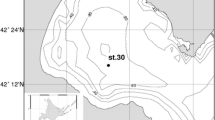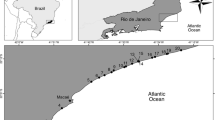Abstract
Through lysis of bacterioplankton cells, viruses mediate an important, but poorly understood, pathway of carbon and nutrients from the particulate to the dissolved form. Via this activity, nutrient-rich cell lysates may become available to noninfected cells and support significant growth. However, the nutritional value of lysates for noninfected bacteria presumably depends on the prevailing nutrient limitation. In the present study, we examined dynamics of dissolved DNA (D-DNA) and viruses along a transect in the phosphorus (P)-limited Öre Estuary, northern Baltic Sea. We found that viruses were an important mortality factor for bacterioplankton and that their activity mediated a significant recycling of carbon and especially of P. Uptake of dissolved DNA accounted for up to 70% of the bacterioplankton P demand, and about a quarter of the D-DNA pool was supplied through viral lysis of bacterial cells. Generally, the importance of viral lysates and uptake of D-DNA was highest at the estuarine and offshore stations and was positively correlated with P limitation measured as alkaline phosphatase activity. Our results highlight the importance of viral activity for the internal recycling of principal nutrients and pinpoints D-DNA as a particularly relevant compound in microbial P dynamics.




Similar content being viewed by others
References
Alonso MC, Rodriguez J, Borrego JJ (1999) Role of ciliates, flagellates and bacteriophages on the mortality of marine bacteria and on dissolved-DNA concentration in laboratory experimental systems. J Exp Mar Biol Ecol 244:239–252
Ammerman JW, Azam F (1985) Bacterial 5′-nucleotidase in aquatic ecosystems: a novel mechanism of phosphorus regeneration. Science 227:1338–1340
Blackburn N, Zweifel UL, Hagström Å (1996) Cycling of marine dissolved organic matter. II. A model analysis. Aquat Microb Ecol 11:79–90
Bongiorni L, Magagnini M, Armeni M, Noble R, Danovaro R (2005) Viral production, decay rates, and life strategies along a trophic gradient in the North Adriatic Sea. Appl Environ Microbiol 71:6644–6650
Brum JR (2005) Concentration, production and turnover of viruses and dissolved DNA pools at Stn ALOHA, North Pacific Subtropical Gyre. Aquat Microb Ecol 41:103–113
Brum JR, Steward GF, Karl DM (2004) A novel method for the measurement of dissolved deoxyribonucleic acid in seawater. Limnol Oceanogr Methods 2:248–255
Chen I, Dubnau D (2004) DNA uptake during bacterial transformation. Nat Rev Microbiol 2:241–249
DeFlauen MF, Paul JH, Jeffrey WH (1987) Distribution and molecular weight of dissolved DNA in subtropical estuarine and oceanic environments. Mar Ecol Prog Ser 38:65–73
Filippini M, Middelboe M (2007) Viral abundance and genome size distribution in the sediment and water column of marine and freshwater ecosystems. FEMS Microbiol Ecol 60:397–410
Fuhrman JA (1992) Bacterioplankton roles in cycling of organic matter: the microbial food web. In: Falkowski PG, Woodhead AD (eds) Primary productivity and biogeochemical cycles in the sea. Plenum, New York, pp 361–383
Fuhrman JA, Azam F (1982) Thymidine incorporation as a measure of heterotrophic bacterioplankton production in marine surface waters: evaluation and field results. Mar Biol 66:109–120
Fuhrman JA, Noble RT (1995) Viruses and protists cause similar bacterial mortality in coastal seawater. Limnol Oceanogr 40:1236–1242
Hagström Å, Larsson U (1984) Diel and seasonal variation in growth rates of pelagic bacteria. In: Hobbie JE, Williams PJLB (eds) Heterotrophic activity in the sea. Plenum, New York, pp 249–262
Hewson I, O’Neil JM, Fuhrman JA, Dennison WC (2001) Virus-like particle distribution and abundance in sediments and overlying waters along eutrophication gradients in two subtropical estuaries. Limnol Oceanogr 46:1734–1746
Jeffrey WH, Von Haven R, Hoch MP, Coffin RB (1996) Bacterioplankton RNA, DNA protein content and relationships to rates of thymidine and leucine incorporation. Aquat Microb Ecol 10:87–95
Jiang SC, Paul JH (1995) Viral contribution to dissolved DNA in the marine environment as determined by differential centrifugation and kingdom probing. Appl Environ Microbiol 61:317–325
Jørgensen NOG, Jacobsen CS (1996) Bacterial uptake and utilization of dissolved DNA. Aquat Microb Ecol 11:263–270
Marie D, Brussaard CPD, Thyrhaug R, Bratbak G, Vaulot D (1999) Enumeration of marine viruses in culture and natural samples by flow cytometry. Appl Environ Microbiol 65:45–52
Middelboe M, Jørgensen NOG (2006) Viral lysis of bacteria: an important source of dissolved amino acids and cell wall compounds. J Mar Biol Ass U K 86:605–612
Middelboe M, Jørgensen NOG, Kroer N (1996) Effects of viruses on nutrient turnover and growth efficiency of noninfected marine bacterioplankton. Appl Environ Microbiol 62:1991–1997
Middelboe M, Lyck PG (2002) Regeneration of dissolved organic matter by viral lysis in marine microbial communities. Aquat Microb Ecol 27:187–194
Middelboe M, Riemann L, Steward GF, Hansen V, Nybroe O (2003) Virus-induced transfer of organic matter between marine bacteria in a model community. Aquat Microb Ecol 33:1–10
Minear RA (1972) Characterization of naturally occurring dissolved organophosphorus compounds. Env Sci Tech 6:431–437
Nausch M (1998) Alkaline phosphatase activities and the relationship to inorganic phosphate in the Pomeranian Bight (southern Baltic Sea). Aquat Microb Ecol 16:87–94
Noble RT, Fuhrman JA (1998) Use of SYBR green I for rapid epifluorescence counts of marine viruses and bacteria. Aquat Microb Ecol 14:113–118
Noble RT, Fuhrman JA (1999) Breakdown and microbial uptake of marine viruses and other lysis products. Aquat Microb Ecol 20:1–11
Parada V, Herndl GJ, Weinbauer MG (2006) Viral burst size of heterotrophic prokaryotes in aquatic systems. J Mar Biol Ass U K 86:613–621
Paul JH, Jeffrey WH, DeFlauen MF (1986) Dynamics of extracellular DNA in the marine environment. Appl Environ Microbiol 53:170–179
Paul JH, DeFlaun MF, Jeffrey WH, David AW (1988) Seasonal and diel variability in dissolved DNA and in microbial biomass and activity in a subtropical estuary. Appl Environ Microbiol 54:718–727
Paul JH, Jeffrey WH, David AW, DeFlauen MF, Cazares LH (1989) Turnover of extracellular DNA in eutrophic and oligotrophic freshwater environments of southwest Florida. Appl Environ Microbiol 55:1823–1828
Riemann L, Middelboe M (2002) Stability of bacterial and viral community compositions in Danish coastal waters as depicted by DNA fingerprinting techniques. Aquat Microb Ecol 27:219–232
Riemann L, Leitet C, Pommier T, Simu K, Holmfeldt K, Larsson U, Hagström Å (2008) The native bacterioplankton community in the central Baltic sea is influenced by freshwater bacterial species. Appl Environ Microbiol 74:503–515
Sandberg J, Andersson A, Johansson S, Wikner J (2004) Pelagic food web structure and carbon budget in the northern Baltic Sea: potential importance of terrigenous carbon. Mar Ecol Prog Ser 268:13–29
Siuda W, Chróst RJ, Gude H (1998) Distribution and origin of dissolved DNA in lakes of different trophic states. Aquat Microb Ecol 15:89–96
Smith DC, Azam F (1992) A simple, economical method for measuring bacterial protein synthesis rates in seawater using 3H-leucine. Mar Microb Food Webs 6:107–114
Steward GF (2000) Fingerprinting viral assemblages by pulsed field gel electrophoresis (PFGE). In: Paul JH (ed) Marine microbiology, methods in microbiology. Academic, New York, pp 85–103
Steward GF, Montiel JL, Azam F (2000) Genome size distributions indicate variability and similarities among marine viral assemblages from diverse environments. Limnol Oceanogr 45:1697–1706
Tezuka Y (1990) Bacterial regeneration of ammonium and phosphate as affected by the carbon:nitrogen:phosphorus ratio of organic substrates. Microb Ecol 19:227–238
Titelman J, Riemann L, Holmfeldt K, Nilsen T (2008) Copepod feeding stimulates bacterioplankton activities in a low phosphorus system. Aquat Biol 2:131–141
Troussellier M, Courties C, Lebaron P, Servais P (1999) Flow cytometric discrimination of bacterial populations in seawater based on SYTO 13 staining of nucleic acids. FEMS Microbiol Ecol 29:319–330
Turk V, Rehnstam A-S, Lundberg E, Hagström Å (1992) Release of bacterial DNA by marine nanoflagellates, an intermediate step in phosphorus regeneration. Appl Environ Microbiol 58:3744–3750
Weinbauer MG, Fuks D, Peduzzi P (1993) Distribution of viruses and dissolved DNA along a coastal trophic gradient in the northern Adriatic sea. Appl Environ Microbiol 59:4074–4082
Weinbauer MG, Fuks D, Puskaric S, Peduzzi P (1995) Diel, seasonal, and depth-related variability of viruses and dissolved DNA in the Northern Adriatic Sea. Microb Ecol 30:25–41
Weinbauer MG, Brettar I, Höfle MG (2003) Lysogeny and virus-induced mortality of bacterioplankton in surface, deep, and anoxic marine waters. Limnol Oceanogr 48:1457–1465
Wilhelm SW, Suttle CA (1999) Viruses and nutrient cycles in the sea. BioSci 49:781–788
Wilhelm SW, Bridgen SM, Suttle CA (2002) A dilution technique for the direct measurement of viral production: a comparison in stratified and tidally mixed coastal waters. Microb Ecol 43:168–173
Winget DM, Williamson KE, Helton RR, Wommack KE (2005) Tangential flow diafiltration: an improved technique for estimation of virioplankton production. Aquat Microb Ecol 41:221–232
Winter C, Herndl GJ, Weinbauer MG (2004) Diel cycles in viral infection of bacterioplankton in the North Sea. Aquat Microb Ecol 35:207–216
Zweifel UL, Norrman B, Hagström Å (1993) Consumption of dissolved organic matter by marine bacteria and demand for inorganic nutrients. Mar Ecol Prog Ser 101:23–32
Zweifel UL, Wikner J, Hagström Å, Lundberg E, Norrman B (1995) Dynamics of dissolved organic carbon in a coastal ecosystem. Limnol Oceanogr 40:299–305
Acknowledgements
We thank C. Stangenberg and the rest of the staff for helping us find our way at the Umeå Marine Sciences Center. We thank J. Wester and M. Molin for help in the field, J. Wikner for providing the thymidine conversion factor, and B. Olsen, University of Kalmar, for use of PFGE equipment. This study was supported by a guest research grant from Umeå Marine Sciences Center to JT and LR and a grant from FORMAS (2006-1054) to JT.
Author information
Authors and Affiliations
Corresponding author
Rights and permissions
About this article
Cite this article
Riemann, L., Holmfeldt, K. & Titelman, J. Importance of Viral Lysis and Dissolved DNA for Bacterioplankton Activity in a P-Limited Estuary, Northern Baltic Sea. Microb Ecol 57, 286–294 (2009). https://doi.org/10.1007/s00248-008-9429-0
Received:
Revised:
Accepted:
Published:
Issue Date:
DOI: https://doi.org/10.1007/s00248-008-9429-0




